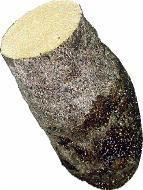


- AP
Triple Olympic gold medallist Usain Bolt is to running what yellow yam is to Trelawny. Both are top in their class. After years of taking the delicious tuber for granted, at the just-concluded Olympics, yam received almost as much attention as our athletes in Beijing, China, did.
Suddenly, everyone wanted to know why Jamaican athletes (particularly Bolt) are so fast. And not wanting to seem boastful, the answer came loud and clear: it's in the (yam) diet.
Many may argue speed is synonymous with Jamaicans and, with no illegal performance-enhancing substances showing up in our athletes' drug test results, it soon seemed logical that, natural talent aside, diet must take some credit.
Yam-producing parishes
And since Bolt is from the island's reputedly best yellow yam-producing parish, the rest is in the 11 medals we won. Perhaps the fact that yellow yam takes the same time to mature that a baby takes to gestate in the womb is also significant.
But, Jamaica is blessed with thousands of acres of fertile, arable land. Among the parishes that produce the best yams are Clarendon, Manchester, St Elizabeth and Trelawny. Some have a gummy texture; other varieties are dry and powdery, while some combine both characteristics.
Already, some sellers are seizing the opportunity to cash in on the heels of the Jamaica's exploits in Beijing.
Origin
It is believed that yam came to the Caribbean from Africa as food for the slaves. It has also been documented that some varieties originated in the Americas.
Yam is generally grown in the Caribbean, Africa, Asia and Mexico. When reaped, it can last for a while and one way to preserve it is actually to leave it buried in the ground after harvesting.Yam must never be eaten raw as it is toxic until cooked.
Now that the once-sleepy community of Sherwood Content in Trelawny has given the world the greatest sprinter of all time, the focus will be on that parish. They have always paid special attention to yellow yam. The Trelawny Yam Festival, which was first staged in 1997, is among the island's favourite gastronomic showcases.
There are up to 18 different varieties of yam in Jamaica, but the yellow yam (Dioscorea cayennennsis) is the most popular. Yam is a source of potassium, a good source of vitamin C, B6, folate, iron and magnesium. Yam is high in starch and contains an enzyme, alpha amylase, which converts starches to sugars.
Bolt's parish accounts for up to 60 per cent of Jamaica's yam production and approximately 50 per cent of the yams exported from Jamaica.
Sources:
http://www.stea.net/tyfaboutyam.html and
http://www.innvista.com/HEALTH/foods/vegetables/yams.htm

